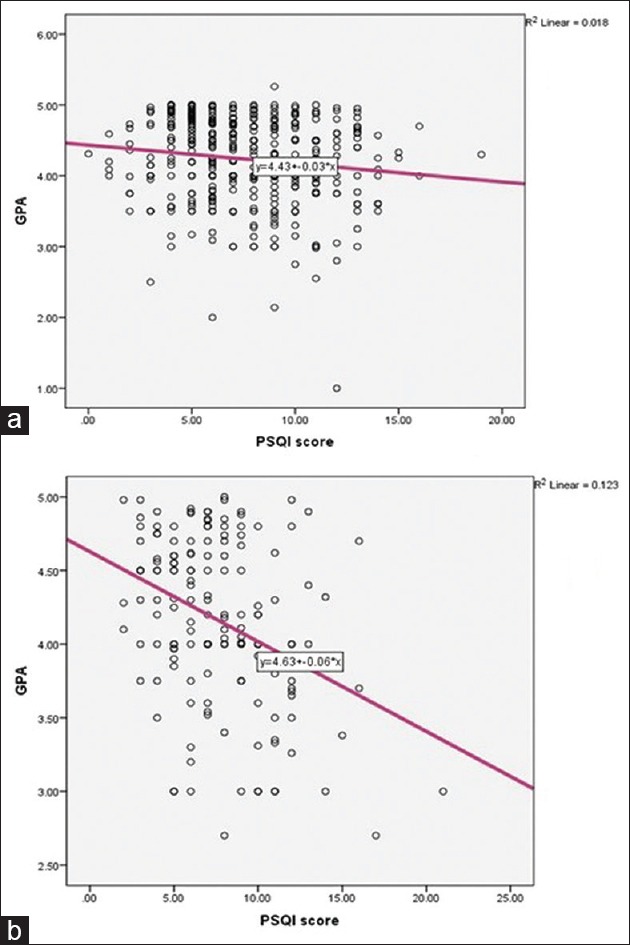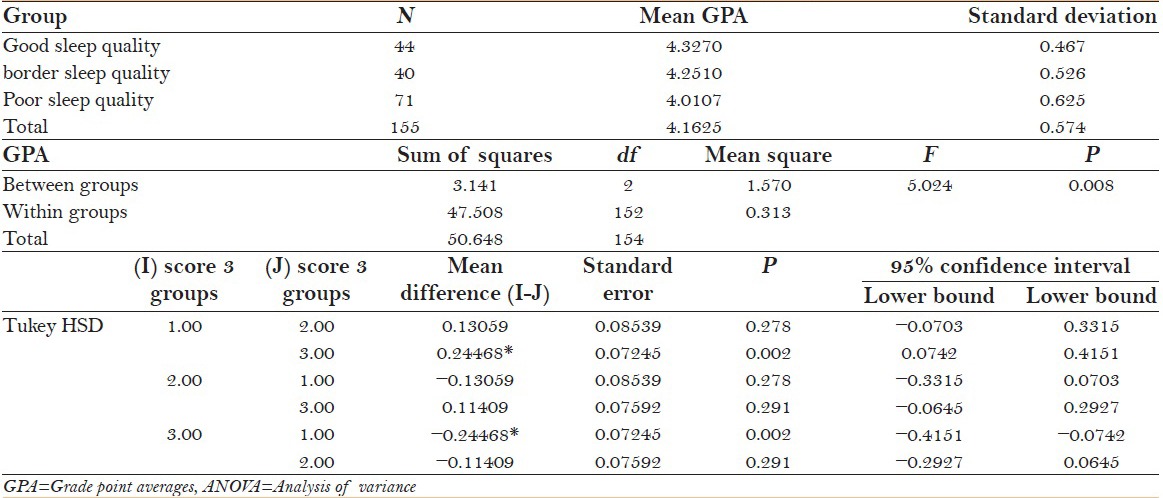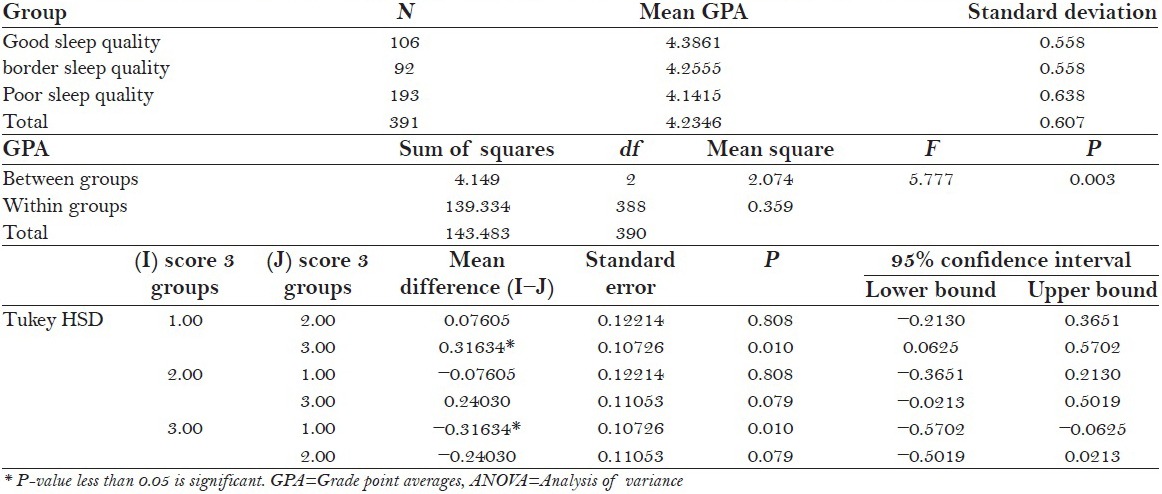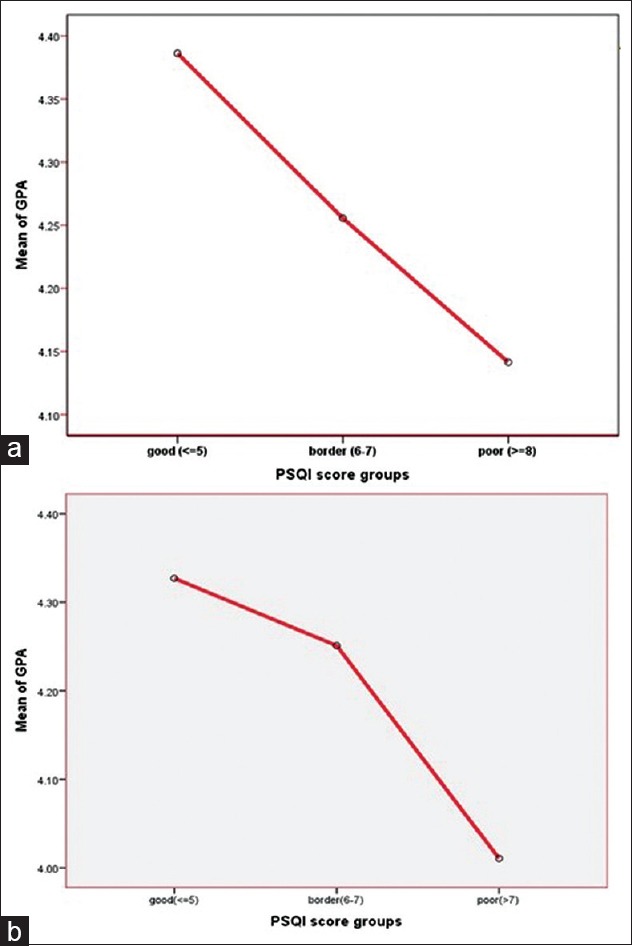Abstract
Objective:
To investigate the sleep patterns of dental students from different academic levels and to determine the effect of sleep patterns on the academic performance of students.
Methods:
A self-reported questionnaire was designed and distributed among 1160 students from clinical and non-clinical levels to measure the sleep-related variables and academic performance. The questionnaire included questions on demographics, sleep habits, sleep quality index (PSQI), and grade point averages (GPAs). Data were analyzed with standard statistical software (SPSS, Statistical Package for the Social Sciences, version 22, Chicago, IL, USA).
Results:
The response rate was 62%. Sixty five percent of the students described their sleep as good or very good, whereas 35% described their sleep as bad or very bad. The mean number of hours of sleep per night for all students was 5.85 ± 1.853 hours. The GPA had a significant negative correlation with PSQI scores. The clinical group showed a stronger negative correlation (P = −0.351) than the nonclinical group (P = −0.134).
Conclusion:
It can be concluded that dental students tend to have poor sleep quality, which is unknown to them. Poor sleep quality was associated with lower academic performance, especially in clinical years.
Key words: Academic, dental students, educational, performance, sleep quality, undergraduate
INTRODUCTION
Dental specialty is often exploited with heavy didactic and clinical content, which exerts heavy stress on students and demands long hours of study and practice. At the same time, dental practice requires high levels of concentration and dexterity which could be affected by a number of factors including the mental, psychological, and physical status of the dentist.[1] The quantity and quality of sleep could be detrimental on the person's quality of life and ability to function, especially for those practicing high physically and mentally demanding professions such as dentistry.
A normal person needs approximately 8 hours of sleep every night to perform daily activities efficiently and maintain good health.[2] Sleep deprivation influences many aspects of a person's life, and it is often associated with poor judgement, disturbed mood, high stress, anxiety, and reduced achievement.[3,4,5] Although reported sleep disorders in adults tend to increase with age, young people often suffer from lack of sleep during their school and college years.[6,7] A meta-analytic review showed that sleepiness, sleep length, and sleep quality are all negatively related to school performance in children and adolescents and that the effect was the strongest for sleepiness, followed by sleep quality and sleep duration.[8]
In the past few decades, many studies have concluded that self-reported short sleep duration, poor sleep quality, late bed and rise times, and irregular sleep schedules are negatively associated with academic performance of students in different populations and academic levels.[9,10,11,12,13,14,15,16,17,18] Most of these studies concluded that students with low sleep quality or disturbed sleep are subjected more to psychological disorders and academic tardiness or even failure.[1,6,14,15,16,17,18] Some studies showed that students' academic performance was affected by the time students went to bed and the time they woke up rather than the total time spent in bed.[1,10]
Most dental students seem to experience sleeping problems that might affect their academic performance as well as their physiological and psychosocial characters. Studies to investigate sleep quality among dental students, in specific, and its effect on their academic performance and practice is lacking.[1,19] Thus, the aim of this study was to investigate, using an objective measure, the sleep quality of dental students at various academic levels, and to assess whether there is an association between their sleep pattern and academic performance.
MATERIALS AND METHODS
This study was held in the female campus of the College of Dentistry in Riyadh Colleges of Dentistry and Pharmacy. The study was registered and approved by the college's ethical committee and research center in full accordance with the world medical association declaration of Helsinki. The participation in this survey was voluntary and anonymous. All the students before their participation in the study provided a written informed consent.
Questionnaire design
A self-reported questionnaire was used to measure sleep-related variables and academic performance. A clear explanation of the aims of the study and the student consent was included on the first page of the questionnaire. The questionnaire included questions on demographics, sleep quality index, and academic performance.
To evaluate students' sleeping habits, the Pittsburgh sleep quality index (PSQI) was used. The PSQI is a twenty-four-item self-rated questionnaire developed to quantify sleep quality and alarm doctors of the necessity to further assess subjects with symptoms of sleep problems. The questionnaire measures seven components of sleep quality and produces a universal score ranging from 0 to 21, with greater scores indicative of poorer quality, and a cut-off score above 5 indicative of poor sleep quality.[20]
Students were asked about their sleep habits and how satisfied they were with their sleep. School performance was measured by the self-reported grade point average (GPA).
The questionnaire was first distributed to a pilot group of students from different levels to obtain feedback on the clarity and readability of questions.
Population and sample
The population selected for this study was all female undergraduate dental students from level two to level 12 (a total of 1160 students). Level-one students were excluded from the study because they do not yet have a GPA. Questionnaires were distributed by hand to all students at the beginning of the first semester in the 2014–2015 academic year, data collection took 3 weeks, and a reminder was sent to all students before the end of the third week to ensure a maximum response rate.
Seven hundred and seventeen students accepted to participate. Any questionnaire with missing data was excluded. A total of 546 undergraduate female students were finally included. Students were classified into two groups according to their academic level: The non-clinical group, including 391 students from level two to level seven, and the clinical group, including 155 students from level eight to level 12.
Data analysis
Data from all questionnaires was encoded first into an excel sheet. An equation was formulated to calculate the global sleep score for each participant as well as the average sleep time for all students. Data were then analyzed with standard statistical software (SPSS, Statistical Package for the Social Sciences, version 22, Chicago, IL, USA). Data was presented as frequencies, percentages, and means ± standard deviation (SD). Categorical data was compared using Chi-square test, the correlation test was used to study the association between GPA and PSQI score for different levels, and the analysis of variance (ANOVA) test was used for analyzing the continuous variables. The results were considered statistically significant when P ≤ 0.05.
RESULTS
The response rate of the questionnaire was 62%. Out of the 546 students included in the study, 354 (64.8%) students described their sleep as good or very good whereas the remaining 192 students (35.2%) described their sleep as bad or very bad.
PSQI scores ranged between 0 and 21 with an average of 7.6 ± 3.396. Three-hundred and ninety six students (72.5%) had scores of more than 5 indicating poor sleep quality. There was no significant difference between the mean sleep score of the non-clinical group (7.6 ± 3) and clinical group (7.6 ± 3) (P = 0.89).
The mean number of sleep hours at night for all students was 5.85 ± 1.853. The number of students who slept 8 hours or more at night was only 115 (21.1%) out of the 546 students. The Chi-square test compared the number of students who slept ≥8 hours in the nonclinical group with those in the clinical group. There was no significant difference between both the groups (Pearson Chi-square = 2.187a; P = 0.139).
GPAs were correlated with PSQI scores. In general, GPA had a significant negative weak correlation with PSQI scores (Pearson correlation = −0.194, r2 = 0.038, P = 0.001). This indicates that students with lower sleep score (ones who sleep better) achieved a significantly higher GPA. Moreover, the clinical group showed a stronger negative correlation (Pearson correlation = −0.351, r2 = 0.123, P = 0.001) [Figure 1a] than the nonclinical group (Pearson correlation = −0.134, r2 = 0.018, P = 0.08) [Figure 1b].
Figure 1.

Correlation between PSQI scores and GPA (a) in nonclinical level students and (b) in clinical level students.
PSQI scores were further divided into three categories: Poor sleep quality (≥8), border sleep quality (6–7), and good sleep quality (≥5).[21]
As shown in Table 1a, b and Figure 2a, b, ANOVA tests revealed a significant difference in the mean GPA between the three groups in both the clinical and nonclinical groups. The good sleep quality group had a higher GPA than the border sleep quality group, and the border sleep quality group had a higher GPA than the poor sleep quality group (P = 0.008 and 0.003, respectively).
Table 1a.
ANOVA examined GPA relation with the 3 sleep quality groups in non-clinical students

Table 1b.
ANOVA examined GPA relation with the 3 sleep quality groups in clinical students

Figure 2.

Mean plot GPA vs. sleep quality groups. (a) Non-clinical level students; (b) clinical level students.
DISCUSSION
Dental specialty exerts heavy stress on students and demands long hours of study and practice, which might exaggerate the poor quality of their sleep.[16] A previous study on dental students investigated the association between sleep habits, in terms of sleeping time and wakefulness and academic performance.[1] In the current study, the PSQI was used as a specific objective measure of sleep quality. This index was developed and validated by Buysse et al.[20] and has been used in many studies and among different populations.[15,16]
In the current study, a high percentage of students described their sleep as good or very good. Similar results were reported by Valic et al.[1] and Serra-Negra et al.[19] On the other hand, the PSQI scores showed that almost 73% of the students scored more than 5 which indicates poor sleep quality; this result was slightly higher than a study conducted on Sudanese medical students which revealed that 61.4% of the students had bad sleep quality.[22] High percentage of students in this study seems to be unaware of their poor sleep quality which concur with results of previous studies on other student populations.[17,21]
Moreover, the results of the current study revealed that only one-fifth of the students slept for an average of 8 or more hours, which is the expected normal sleep duration.[2] Serra-Negra et al.[19] showed similar results where 20.8% of students slept an average of 8 hours or more. The average number of sleep hours among all students was almost 6 hours, which is similar to that reported in different undergraduate student populations.[3,19,23]
The association between poor sleep quality and academic performance was explored in this study. Because dental schools students have a different study rhythm in the clinical years in comparison with the nonclinical years, the relationship between sleep quality score and academic performance was examined separately for each group. Although a significant negative correlation between PSQI scores and GPA existed in both groups, the negative correlation was stronger among clinical students. Dental studies and practice, especially in the clinical years, require high levels of concentration, cognitive performance, and motor dexterity. Poor sleep quality or sleep deprivation can affect performance negatively.[18,24] Moreover, poor sleep quality and daytime sleepiness reduce levels of attention, elevate level of anxiety, affect cognitive performance, and may impair memory and decision making,[4,5,24] which could be a contributing factor for the stronger negative association between sleep quality and academic performance in the clinical years.
In light of the evidence presented in this study, the poor quality of sleep among dental students can be considered an alarming condition that might affect their academic performance as well as their health. This issue needs further investigation.
There are two limitations that must be taken into consideration when interpreting the results of the current study. The study was carried out in a female dental college. Further studies that include both female and male students can provide better generalization of the results and comparison between the genders. The GPA was self-reported so the reporting depended completely on the student's honesty. However, the voluntary and anonymous participation in the study would make dishonesty in this matter a remote possibility. Self-reported GPA was considered as a reliable measure for academic performance in many similar studies.[1,3,6,16]
CONCLUSIONS
Based on the findings of this study, dental students in general have poor sleep quality, which may be unknown to them. It can also be concluded that sleep quality plays a significant role in the academic performance of dental students, especially in the clinical years. Students should accustom themselves to a healthier sleep pattern to enhance their academic performance and avoid related health and psychological hazards.
Financial support and sponsorship
Nil.
Conflicts of interest
Authors declare that there is no conflict of interests regarding the publication of this article.
Acknowledgments
None declared.
REFERENCES
- 1.Valic M, Pecotic R, Lusic L, Peros K, Pribudic Z, Dogas Z. The relationship between sleep habits and academic performance in dental students in Croatia. Eur J Dent Educ. 2014;18:187–94. doi: 10.1111/eje.12081. [DOI] [PubMed] [Google Scholar]
- 2.Roehrs T, Shore E, Papineau K, Rosenthal L, Roth T. A two-week sleep extension in sleepy normals. Sleep. 1996;19:576–82. [PubMed] [Google Scholar]
- 3.Gilbert S, Weaver C. Sleep quality and academic performance in university students: A wake-up call for college psychologists. J Coll Stud Psychother. 2010;24:295–306. [Google Scholar]
- 4.Killgore WD. Effects of sleep deprivation on cognition. Prog Brain Res. 2010;185:105–29. doi: 10.1016/B978-0-444-53702-7.00007-5. [DOI] [PubMed] [Google Scholar]
- 5.Choueiry N, Salamoun T, Jabbour H, El Osta N, Hajj A, Rabbaa Khabbaz L. Insomnia and relationship with anxiety in university students: A cross-sectional designed study. PLoS One. 2016;11:e0149643. doi: 10.1371/journal.pone.0149643. [DOI] [PMC free article] [PubMed] [Google Scholar]
- 6.Ahrberg K, Dresler M, Niedermaier S, Steiger A, Genzel L. The interaction between sleep quality and academic performance. J Psychiatr Res. 2012;46:1618–22. doi: 10.1016/j.jpsychires.2012.09.008. [DOI] [PubMed] [Google Scholar]
- 7.Merdad RA, Merdad LA, Nassif RA, El-Derwi D, Wali SO. Sleep habits in adolescents of Saudi Arabia; distinct patterns and extreme sleep schedules. Sleep Med. 2014;15:1370–8. doi: 10.1016/j.sleep.2014.06.008. [DOI] [PubMed] [Google Scholar]
- 8.Dewald JF, Meijer AM, Oort FJ, Kerkhof GA, Bögels SM. The influence of sleep quality, sleep duration, and sleepiness on school performance in children and adolescents: A meta-analytic review. Sleep Med Rev. 2010;4:179–89. doi: 10.1016/j.smrv.2009.10.004. [DOI] [PubMed] [Google Scholar]
- 9.Schmidt RE, Van der Linden M. The relations between sleep, personality, behavioral problems, and school performance in adolescents. Sleep Med Clin. 2015;10:117–23. doi: 10.1016/j.jsmc.2015.02.007. [DOI] [PubMed] [Google Scholar]
- 10.Curcio G, Ferrara M, De Gennaro L. Sleep loss, learning capacity and academic performance. Sleep Med Rev. 2006;10:323–37. doi: 10.1016/j.smrv.2005.11.001. [DOI] [PubMed] [Google Scholar]
- 11.Trockel M, Barnes M, Egget D. Health-related variables and academic performance among first-year college students: Implications for sleep and other behaviors. J Am Coll Health. 2000;49:125–31. doi: 10.1080/07448480009596294. [DOI] [PubMed] [Google Scholar]
- 12.Kelly W, Kelly K, Clanton R. The relationship between sleep length and grade-point average among college students. Coll Stud J. 2001;35:84–6. [Google Scholar]
- 13.Williams T, Aderanti R. Sleep as a determinant of academic performance of university students in Ogun state, South west, Nigeria. Eur Sci J. 2014;10:657–64. [Google Scholar]
- 14.Eliasson A, Eliasson A, King J, Gould B, Eliasson A. Association of sleep and academic performance. Sleep Breath. 2002;6:45–8. doi: 10.1007/s11325-002-0045-9. [DOI] [PubMed] [Google Scholar]
- 15.Gaultney JF. The prevalence of sleep disorders in college students: Impact on academic performance. J Am Coll Health. 2010;59:91–7. doi: 10.1080/07448481.2010.483708. [DOI] [PubMed] [Google Scholar]
- 16.Bahammam AS, Alaseem AM, Alzakri AA, Almeneessier AS, Sharif MM. The relationship between sleep and wake habits and academic performance in medical students: A cross-sectional study. BMC Med Educ. 2012;12:61. doi: 10.1186/1472-6920-12-61. [DOI] [PMC free article] [PubMed] [Google Scholar]
- 17.Assaad S, Costanian C, Haddad G, Tannous F. Sleep patterns and disorders among university students in Lebanon. J Res Health Sci. 2014;14:198–204. [PubMed] [Google Scholar]
- 18.Lemma S, Berhane Y, Worku A, Gelaye B, Williams MA. Good sleep quality is associated with better academic performance among university students in Ethiopia. Sleep Breath. 2014;18:257–63. doi: 10.1007/s11325-013-0874-8. [DOI] [PMC free article] [PubMed] [Google Scholar]
- 19.Serra-Negra JM, Scarpelli AC, Tirsa-Costa D, Guimarães FH, Pordeus IA, Paiva SM. Sleep bruxism, awake bruxism and sleep quality among Brazilian dental students: A cross-sectional study. Braz Dent J. 2014;25:241–7. doi: 10.1590/0103-6440201302429. [DOI] [PubMed] [Google Scholar]
- 20.Buysse DJ, Reynolds CF, Monk TH, Berman SR, Kupfer DJ. The Pittsburgh Sleep Quality Index (PSQI): A new instrument for psychiatric research and practice. Psychiatry Res. 1989;28:193–213. doi: 10.1016/0165-1781(89)90047-4. [DOI] [PubMed] [Google Scholar]
- 21.Lund H, Reider B, Whiting A, Prichard J. Sleep patterns and predictors of disturbed sleep in a large population of college students. J Adolesc Health. 2009;46:124–32. doi: 10.1016/j.jadohealth.2009.06.016. [DOI] [PubMed] [Google Scholar]
- 22.Mirghani HO, Mohammed OS, Almurtadha YM, Amed MS. Good sleep quality is associated with better academic performance among Sudanese medical students. BMC Res Notes. 2015;8:706. doi: 10.1186/s13104-015-1712-9. [DOI] [PMC free article] [PubMed] [Google Scholar]
- 23.Alsaggaf MA, Wali SO, Merdad RA, Merdad LA. Sleep quantity, quality, and insomnia symptoms of medical students during clinical years. Saudi Med J. 2016;37:173–82. doi: 10.15537/smj.2016.2.14288. [DOI] [PMC free article] [PubMed] [Google Scholar]
- 24.Lo JC, Loh KK, Zheng H, Sim SK, Chee MW. Sleep duration and age-related changes in brain structure and cognitive performance. Sleep. 2014;37:1171–8. doi: 10.5665/sleep.3832. [DOI] [PMC free article] [PubMed] [Google Scholar]


